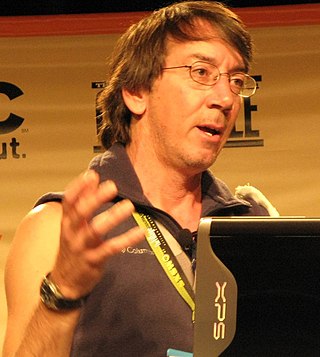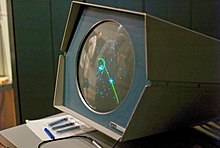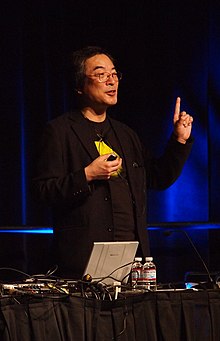Portal:Video games
The Video Games Portal

A video game or computer game is an electronic game that involves interaction with a user interface or input device (such as a joystick, controller, keyboard, or motion sensing device) to generate visual feedback from a display device, most commonly shown in a video format on a television set, computer monitor, flat-panel display or touchscreen on handheld devices, or a virtual reality headset. Most modern video games are audiovisual, with audio complement delivered through speakers or headphones, and sometimes also with other types of sensory feedback (e.g., haptic technology that provides tactile sensations). Some video games also allow microphone and webcam inputs for in-game chatting and livestreaming.
Video games are typically categorized according to their hardware platform, which traditionally includes arcade video games, console games, and computer (PC) games; the latter also encompasses LAN games, online games, and browser games. More recently, the video game industry has expanded onto mobile gaming through mobile devices (such as smartphones and tablet computers), virtual and augmented reality systems, and remote cloud gaming. Video games are also classified into a wide range of genres based on their style of gameplay and target audience. (Full article...)
Featured articles –
Spacewar! is a space combat video game developed in 1962 by Steve Russell in collaboration with Martin Graetz, Wayne Wiitanen, Bob Saunders, Steve Piner, and others. It was written for the newly installed DEC PDP-1 minicomputer at the Massachusetts Institute of Technology. After its initial creation, Spacewar! was expanded further by other students and employees of universities in the area, including Dan Edwards and Peter Samson. It was also spread to many of the few dozen installations of the PDP-1 computer, making Spacewar! the first known video game to be played at multiple computer installations.
The game features two spaceships, "the needle" and "the wedge", engaged in a dogfight while maneuvering in the gravity well of a star. Both ships are controlled by human players. Each ship has limited weaponry and fuel for maneuvering, and the ships remain in motion even when the player is not accelerating. Flying near the star to provide a gravity assist was a common tactic. Ships are destroyed when they collide with a torpedo, the star, or each other. At any time, the player can engage a hyperspace feature to move to a new and random location on the screen, though in some versions each use has an increasing chance of destroying the ship instead. The game was initially controlled with switches on the PDP-1, though Bob Saunders built an early gamepad to reduce the difficulty and awkwardness of controlling the game.
Spacewar! is one of the most important and influential games in the early history of video games. It was extremely popular in the small programming community in the 1960s and the public domain code was widely ported to and recreated on other computer systems at the time, especially after computer systems with monitors became more widespread towards the end of the decade. It has also been recreated in more modern programming languages for PDP-1 emulators. It directly inspired many other video games, such as the first commercial arcade video games, Galaxy Game and Computer Space (both from 1971), and later games such as Asteroids (1979). In 2007, Spacewar! was named to a list of the ten most important video games in history, which formed the start of the game canon at the Library of Congress, and in 2018 it was inducted into the World Video Game Hall of Fame by The Strong and the International Center for the History of Electronic Games. (Full article...)
The game began development in 2008. Key first conceived Proteus as an open-ended role-playing game akin to The Elder Scrolls IV: Oblivion but, because of the work required for such a project, later redesigned it to be "nontraditional and nonviolent". Audio designer and composer David Kanaga joined the project in 2010. Versions for the PlayStation 3 video game console and Vita handheld console were developed by Curve Studios, whose team added new gameplay features to the Vita edition at Sony's request.
Proteus won the prize for Best Audio at the 2011 IndieCade awards, and was a finalist for the 2012 Independent Games Festival's Nuovo Award. Following its release, critics praised the game, especially for its audio features, although some criticised the game's brevity and limited replayability. The game was frequently mentioned in discussions of video games as art, with some debating whether it could be considered a video game at all. (Full article...)
The game was Rare's first game for the Nintendo 64. Its development team ranged between four and seven members, many of whom were recent graduates. The team sought to find gameplay to fit Rare co-founder Chris Stamper's idea for a building destruction game. The puzzle game mechanics were inspired by those of Donkey Kong (1994).
Blast Corps was released to critical acclaim and received Metacritic's second highest Nintendo 64 game ratings of 1997. The game sold one million copies—lower than the team's expectations—and received several editor's choice awards. Reviewers praised its originality, variety, and graphics, but some criticized its controls and repetition. Reviewers of Rare's 2015 Rare Replay retrospective compilation noted Blast Corps as a standout title. (Full article...)
Homeworld was created over two years, and was the first game developed by Relic. Studio co-founders Alex Garden and Luke Moloney served as the director and lead programmer. The initial concept for the story is credited to writer David J. Williams, while the script itself was written by Martin Cirulis and the background lore was written by author Arinn Dembo. The music was written by composer Paul Ruskay as the first game from his Studio X Labs, with the exceptions of Samuel Barber's 1936 Adagio for Strings, considered the defining theme of the game, and a licensed track from English rock band Yes, "Homeworld (The Ladder)".
Homeworld is listed by review aggregator Metacritic as the highest-rated computer game of 1999, and the third-highest on any platform for the year. Critics praised the graphics, unique gameplay elements, and multiplayer system, though opinions were divided on the plot and high difficulty. The game sold over 500,000 copies in its first six months, and received several awards and nominations for best strategy game of the year and best game of the year. A release of the source code in 2003 sparked unofficial ports to Mac OS X and Linux, and three more games in the Homeworld series have been produced: Homeworld: Cataclysm (2000), Homeworld 2 (2003), and Homeworld: Deserts of Kharak (2016). Gearbox Software purchased the rights to the series from then-owners THQ in 2013, and released a remastered collection of Homeworld and Homeworld 2 in 2015 for Windows and OS X which was also highly regarded. In August 2019, Gearbox announced the fifth game in the series, Homeworld 3; the game was developed by Blackbird Interactive, partially crowdfunded through Fig, and released in 2024. (Full article...)
The Flash version of Flow received 100,000 downloads within its first two weeks of release, and had been played over 3.5 million times by 2008. Its PlayStation 3 re-release was the most downloaded game on the PlayStation Network in 2007 and won the Best Downloadable Game award at the 2008 Game Developers Choice Awards. It was nominated for awards by the Academy of Interactive Arts & Sciences and the British Academy of Film and Television Arts (BAFTA). Reviewers praised Flow's visual and audio appeal, but noted the simplicity of its gameplay; several considered it to be more of an art piece than a game. (Full article...)

The Menacer is a light gun peripheral released by Sega in 1992 for its Sega Genesis and Sega CD video game consoles. It was created in response to Nintendo's Super Scope and as Sega's successor to the Master System Light Phaser. The gun is built from three detachable parts (pistol, shoulder stock, sights), and communicates with the television via an infrared sensor. The Menacer was announced at the May 1992 Consumer Electronics Show in Chicago and was released later that year. The gun was bundled with a pack-in six-game cartridge of mostly shooting gallery games. Sega also released a Menacer bundle with Terminator 2: The Arcade Game.
Sega producer Mac Senour was responsible for the Menacer project and designed the six-game pack. He originally proposed non-shooting minigames based on existing Sega licenses like Joe Montana, David Robinson, and ToeJam & Earl, but most of the prototypes were abandoned due to high cost in favor of more shooting-type games. Sega did not plan another first-party release for the Menacer apart from the included multicart. Compatible games were published through 1995.
The Menacer is remembered as a critical and commercial flop. Critics found the six-game pack subpar and repetitive, and criticized the peripheral's lack of games. The ToeJam & Earl spinoff game was held in the highest regard, and reviewers recommended the Menacer-compatible Terminator 2 game. A direct-to-TV light gun that includes the six-game Menacer pack was released in 2005. (Full article...)
Halo 2 had originally been intended to wrap up the story begun with Combat Evolved, but development difficulties led to a cliffhanger ending. Bungie began developing Halo 3 shortly after Halo 2 shipped. The game was officially announced at E3 2006, and its release was preceded by a multiplayer beta open to select players who purchased the Xbox 360 game Crackdown. Microsoft spent $40 million on marketing the game, in an effort to sell more game consoles and broaden the appeal of the game beyond the established Halo fanbase. Marketing included cross-promotions and an alternate reality game.
Halo 3 was released on September 25 and grossed US$170 million on its first day of release, rising to $300 million in its first week. The game sold in excess of 14.5 million copies and was the best-selling video game of 2007 in the United States. More than one million people played Halo 3 on Xbox Live in the first twenty hours. Overall, the game was well received by critics, with the Forge and multiplayer offerings singled out as strong features; however, some reviewers criticized single-player aspects, especially the plot and campaign layout. Halo 3 is frequently listed as one of the greatest video games of all time. A sequel, Halo 4, released in November 2012, was developed by 343 Industries. Halo 3 was re-released as part of Halo: The Master Chief Collection for the Xbox One in November 2014 and for Microsoft Windows on July 14, 2020. (Full article...)
Ultimate released Knight Lore third in the Sabreman series but later claimed to have completed it first and withheld its release for a year to position the company advantageously in anticipation of the game's effect on the market. Knight Lore's novel image masking technique, Filmation, let images appear to pass atop and behind each other without their contents colliding. This created the illusion of depth priority, which the computer did not natively support. By delaying Knight Lore's release, Ultimate protected sales of their then-upcoming Sabre Wulf and created another Filmation game before other developers could copy the style. Ultimate released the original Sabreman trilogy in quick succession in 1984 for the ZX Spectrum. Knight Lore came last, in November. Ports followed for the BBC Micro, Amstrad CPC, MSX, and Family Computer Disk System.
Knight Lore is regarded as a seminal work in British video game history and has been included in multiple lists of top Spectrum games. Critics considered its technical solutions and isometric 3D style a harbinger of future game design. They praised the game's controls and atmosphere of mystery, but noted its difficult gameplay and criticised its sound and occasional graphical slowdown. Knight Lore was named the 1984 game of the year by the Golden Joystick Awards and Popular Computing Weekly readers. Though it was not the first isometric 3D video game, Knight Lore popularised the format. When the isometric, flip-screen style fell out of fashion, Knight Lore's influence persisted in computer role-playing games. Retrospective reviewers remember the game as the first to offer an exploratory "world" rather than a flat surface, but consider its controls outdated and frustrating in the thirty years since its release. (Full article...)
Did you know... -
- ... that MicroProse was formed to publish Hellcat Ace after Sid Meier boasted that he could design a better video game than Red Baron in a week?
- ... that the 1999 video game Interplay Sports Baseball Edition 2000 used a public-address announcer while its rivals were switching to two commentators as featured on real MLB game broadcasts?
- ... that the album series Jingle Cats spawned Jingle Dogs, Jingle Babies, and a Japanese video game in which "the object is to breed and care for cats, which begin to sing when they're done copulating"?
- ... that the robotic enemies in the video game The Incredible Hulk were influenced by Marvel Comics' objection to the Hulk killing humanoid characters?
- ... that approximately 85 percent of Manhattan was recreated for the 2008 video game The Incredible Hulk?
- ... that Through the Darkest of Times was the first video game published in Germany to use swastikas?
- ... that the game designer of the video game Hades said that the characters were attractive "because Jen Zee"?
- ... that Tetris Holding won an injunction in 2012 to stop sales of a video game clone of their famed Tetris game?
- ... that Rawson Stovall became the first nationally syndicated video game journalist in the United States when he was only eleven years old?
- ... that the 1987 video game Oriental Hero was panned as "so incredibly bad it's almost worth a look"?
- ... that the web-based video game Moderator Mayhem was based on a card game meant to demonstrate the difficulties of content moderation?
- ... that Terra Invicta's development company is a group of former volunteer video game modders that decided to release their own game after the success of their mod?
Selected biography –
Selected image -

- May 24, 2024 – Uvalde school shooting
- Families in Uvalde, Texas, U.S., file a lawsuit against Daniel Defense and Activision Blizzard for creating the DDM4 V7 gun and promoting the weapon through the game Call of Duty, respectively. They also sue Meta Platforms for owning Instagram, which was used by the gunman. (AP)
- April 16, 2024 – 2023–2024 video game industry layoffs
- American video game company Take-Two Interactive lays off 5% of its workforce. (Reuters)
- April 10, 2024 – 2023–2024 video game industry layoffs
- American video game company Epic Games announces that it will lay-off around 870 employees, roughly one-sixth of its workforce, due to slower growth than expected. (CBC via Yahoo! News)
Topics
Categories
Things you can do
In other Wikimedia projects
The following Wikimedia Foundation sister projects provide more on this subject:
-
Commons
Free media repository -
Wikibooks
Free textbooks and manuals -
Wikidata
Free knowledge base -
Wikinews
Free-content news -
Wikiquote
Collection of quotations -
Wikisource
Free-content library -
Wikiversity
Free learning tools -
Wiktionary
Dictionary and thesaurus















































